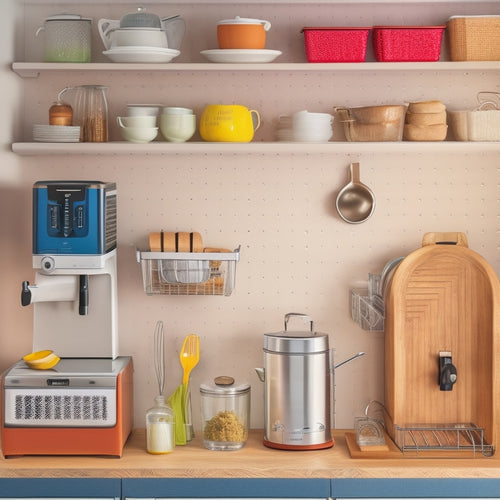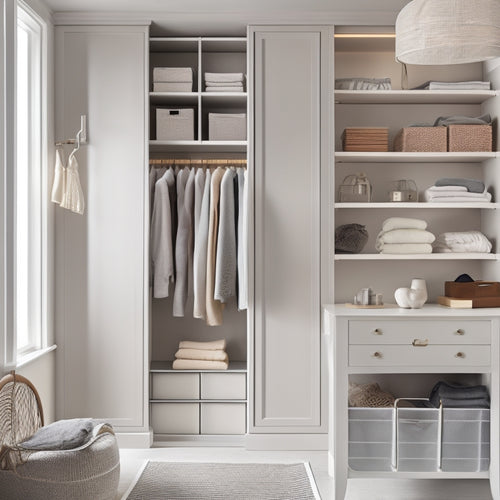
Why Waste Space: Unlocking Basement Storage Potential
Share
You're wasting valuable space in your basement, but it's time to transform it into a storage haven! Start by evaluating your space, taking note of dimensions, layout, and existing features. Identify obstructions and visualize the flow of traffic to determine the best use of space. Enroll in courses to learn strategic storage optimization and decluttering techniques. Then, get creative with DIY storage solutions like shelving units, hidden storage spaces, and labeling systems. With ideal lighting and effective shelving, you'll be on your way to unleashing your basement's full potential - and unlocking a more organized, clutter-free life, too.
Key Takeaways
• Assess your basement space by measuring dimensions, identifying obstructions, and noting existing features to maximize storage potential.
• Enroll in courses or learn about strategic storage optimization, space planning, and decluttering techniques to optimize your basement storage.
• Implement DIY storage solutions such as shelving units, hidden storage spaces, and labeling systems to create a functional and organized space.
• Ensure effective shelving and racking by customizing height and width, designating spots for every item, and considering load capacity for a clutter-free space.
• Adopt a decluttering mindset, speed sort items, and let go of unnecessary belongings to unlock your basement's full storage potential.
Assessing Your Basement Space
Take stock of your basement's current state by walking through the space and making a mental note of its dimensions, layout, and existing features. Measure the length, width, and height of your basement to determine its total square footage. Identify any obstructions, such as pillars, ductwork, or plumbing, that could impact your storage plans. Note the location of windows, doors, and any built-in shelving or cabinets.
Visualize your basement layout, considering the flow of traffic and how you want to use the space. Think about the activities you'll be using the space for, such as a home gym, play area, or home office. Identify any areas that could be repurposed for storage.
Make a list of the items you want to store and prioritize them based on frequency of use.
Courses on Maximizing Storage Space
Maximizing your basement storage space requires a strategic approach, and enrolling in courses or online tutorials can provide you with the necessary skills to optimize your space efficiently. These courses will teach you the fundamentals of space planning, helping you to explore your basement's layout and identify areas for improvement. You'll learn how to create a functional storage system that suits your needs, making the most of every nook and cranny.
Moreover, courses on maximizing storage space will investigate the psychology of storage, revealing how your habits and behaviors impact your storage needs. You'll discover how to declutter and organize your belongings, breaking free from the cycle of clutter and chaos.
DIY Storage Solution Ideas
When you begin designing your DIY storage solutions, you'll want to contemplate a few key elements to maximize your basement's potential.
You'll need to think about how to create functional shelving units, utilize hidden storage spaces, and implement a labeling system that makes sense.
Shelving Unit Ideas
$ |
$ }}} $ $,. } ,
.. .. $ }
. }$$ $,
$$
}
$$$ $
$ “.} $ system }
}
} $} }.}$} } $$}
, $.$$$ } update$ }
).c$ ,}$$
}$ “ ($,| The The ,$}}$}
$ $ } $ 1 $ .}
,$$ The The $} $ }
$ $$} } } The
|
$ }} .} }} $ $} } $} } }
The$ }. }$ $$}
$ The .
. } The.}
} The, } }},$}
}}$$
,}$ } } .. }
$}) The | The }
$
}
$$ $} .
.$$
$ }}
"$ |}.c
$
$ $ }} $ It } $
$-$
$
.} (. $$
$
$ } } $ The.$
} .$ }
$ $$
This$$ }
} | The .} } .
$}
$ S} } }. $
,
| The $ $ The for $ }}$
$ }$
}} .
$}
$ $
$ $}
$$ .}
$
.
}
The} ,} .
} The $
|. $.$}$ ( The }$ .
$ },$ $. )
$$
} } } } ,
$ }
} .$
$ .gov } $ .$} The
} The system
$}
$ }
. }$
}
$}q}$ $
,
|$$$
} .
} $ ,}
$
}.$.
}$ ${$} http}$ $$$
}
.$}$ to $ $}$$
-} } .} The$
$
$ $
The
}} $,} field. $
Hidden Storage Spaces
Create hidden storage spaces in your basement by repurposing unexpected areas, such as under stairs, behind walls, or inside furniture, to stash items out of sight while keeping them easily accessible.
You can convert these areas into secret compartments that blend seamlessly into your basement's décor. For instance, you can install a sliding panel or a hidden door to conceal storage bins or shelves.
Another clever idea is to create false bottoms in your furniture, such as an ottoman or a coffee table, to store items like linens, out-of-season clothes, or even valuable items.
To take it a step further, consider installing hidden shelves or drawers that can be accessed by pulling out a book or a decorative item. These secret storage spaces won't only keep your basement organized but also add a touch of sophistication and whimsy to the area.
Labeling System Tips
You've cleverly carved out hidden storage spaces in your basement, but now it's time to make sure you can easily find what you need by implementing a thoughtful labeling system. A well-planned labeling system will help you quickly identify what's stored in each area, saving you time and frustration.
To create an effective labeling system, start by establishing a label hierarchy. This means categorizing your labels into main categories, subcategories, and individual items.
For example, you might have a main category for 'Seasonal Decorations,' a subcategory for 'Christmas,' and individual labels for 'Ornaments,' 'Lights,' and 'Tree Decor.'
Use color coding to further distinguish between categories. Assign a specific color to each main category, and use variations of that color for subcategories. This visual system will make it easy to scan your storage areas and find what you need.
Effective Shelving and Racking
With the right shelving and racking system, your basement storage space can transform from cluttered chaos to organized oasis. You'll be able to find what you need in seconds, and make the most of your available space.
To achieve this, you'll want to focus on installing adjustable frames that can be tailored to fit your unique storage needs. These frames allow you to customize the height and width of your shelves, ensuring that every item has a designated spot.
Additionally, consider the load capacity of your shelving system. You don't want your shelves collapsing under the weight of heavy items, so make sure to choose racks that can handle the weight of your stored goods.
Optimal Lighting for Storage
Proper lighting illuminates every nook and cranny of your basement storage space, allowing you to quickly locate items, read labels, and navigate narrow aisles with confidence. As you design your storage space, consider the importance of natural lighting. If possible, position shelving units near windows or install skylights to take advantage of natural light. This not only saves energy but also creates a more welcoming atmosphere.
However, natural lighting mightn't be sufficient, especially in areas with limited window space. That's where task lighting comes in. Install LED strip lights, pendant lights, or under-shelf lighting to focus light exactly where you need it. This targeted lighting helps you spot small items, read labels, and perform tasks efficiently.
Additionally, consider motion-sensing lights or timers to conserve energy and prolong the lifespan of your lighting fixtures.
Decluttering for Maximum Efficiency
Now that your basement storage space is well-lit, it's time to tackle the clutter that's been hiding in the shadows, and organizing your belongings is the key to revealing the full potential of your space. To get started, you'll need to adopt a 'clutter mindset' – being honest with yourself about what you really need and what can go.
Then, it's time for some 'speed sorting'. Set up three boxes or bins labeled 'keep', 'donate/sell', and 'toss', and quickly sort items into each category. Be ruthless – if you haven't used it in the past year, it's likely you won't miss it.
As you sort, visualize how you want your space to look and function. What do you need easy access to? What can be stored out of the way? Keep your goals in mind as you work through the clutter, and remember, it's okay to let go of items that no longer serve you.
Frequently Asked Questions
Can I Convert My Basement Into a Livable Space With Storage?
'Like an artist with a blank canvas, you can transform your basement into a livable space with storage. By optimizing your basement layout and leveraging design flexibility, you'll reveal a functional oasis that's both beautiful and practical.'
How Do I Keep Stored Items From Getting Damp or Moldy?
You'll prevent stored items from getting damp or moldy by controlling the climate with a dehumidifier and installing moisture barriers, like waterproof bins and shelving, to block humidity and keep air circulating around your stored items.
Are There Any Specific Building Codes for Basement Storage?
You'll need to comply with local building codes for basement storage, including fireproofing regulations and structural requirements, to guarantee safety and durability; check with local authorities for specific guidelines and permits required.
Can I Use My Basement for Storing Hazardous Materials?
Make sure you don't store hazardous materials in your basement without strict safety protocols in place, as they can pose risks to you and the environment. Be certain you understand local regulations and consider the environmental impact before storing any hazardous substances.
How Often Should I Inspect and Maintain My Basement Storage Area?
'A stitch in time saves nine' is especially true for your basement storage area! You should inspect and maintain it regularly, ideally with seasonal audits, to prevent pest control issues and make sure everything remains organized and easily accessible.
Related Posts
-

Smart Storage for Small Kitchen Appliances
You can optimize your small kitchen's functionality by implementing smart storage solutions that efficiently stash sm...
-

Organize Your Digital Photos With These Online Courses
You've accumulated thousands of digital photos, and finding a specific one has become overwhelming. It's time to orga...
-

Mastering Small Closet Organization: Proven Strategies Unlocked
You're about to reveal the secret to transforming your small closet into a functional haven, where every item has its...


